Rururban Partnerships: Urban Accessibility and Its Influence on the Stabilization of the Population in Rural Territories (Extremadura, Spain)
Abstract
1. Introduction
2. European Policy of Urban and Rural Integration
- (1)
- Areas integrated into the global economy, which are experiencing economic growth;
- (2)
- Intermediate rural areas relatively far from urban centers, but with good transport links and reasonably well-developed infrastructure, which tend to have stable population and to be in the process of diversifying economically;
- (3)
- Isolated rural areas that are sparsely populated and often situated in peripheral areas, far from urban centers and main transport networks. Their population is generally dependent on agriculture and in decline, as well as they tend to have an aging population, poor infrastructure endowment, a low level of basic services, low income per head and a poorly qualified work force. Furthermore, these areas are not usually well integrated into the global economy, so there is a need to develop links with towns even if they are relatively far away.
3. Materials and Methods
- (a)
- The first hypothesis is based on the consideration that Extremadura has a system of cities well distributed throughout the territory, forming a polycentric urban system. To respond to this hypothesis, the main cities of the region have been selected, those with more than 10,000 inhabitants, which according to the criteria of the National statistics institute (INE) are the nuclei considered to be urban in Spain. However, in addition, resorting to the evolution of the population, they are the only nuclei that present a positive demographic trend throughout the 20th century until very recently. They are located in the most developed areas with population densities around the national averages. All the municipalities below this threshold, on the other hand, have a negative evolution.
- (b)
- In the second specific hypothesis (Figure 1), which concerns accessibility, it is assumed that urban areas are articulated according to distance and the transport system and accessibility, with an influence that is degraded according to the time and resources invested in travel.
4. Results
4.1. Urban Polycentrism in Rural Areas
4.2. Urban Accessibility and Stabilization of the Rural Population
5. Discussion and Conclusions
Author Contributions
Funding
Conflicts of Interest
References
- Comunicación de la Comisión al Consejo y al Parlamento Europeo: ’Europa 2000’: Perspectivas del Desarrollo del Territorio de la Comunidad Comisión de las Comunidades Europeas; Comisión Europea: Brussels, Belgium, 1990.
- Agenda Urbana Española 2019; Ministerio de Fomento: Madrid, Spain, 2019.
- Hernández Luque, J.M. La Reforma de la Política Agraria Común para el período 2021–2027. Rev. Desarro. Rural (CEIPREX y ADERCO) 2019, XXIV. NO. 43. [Google Scholar]
- Ponencia de estudio para la adopción de medidas en relación con la despoblación rural en España, constituida en el seno de la Comisión de Entidades Locales. In Boletín Oficial de las Cortes Generales (BOCG); Senado: Spain, 2015.
- Comisionado Nacional para el Reto Demográfico. La Estrategia Nacional frente al Reto Demográfico; Ministerio de Política Territorial y Función Pública: Madrid, Spain, 2019. [Google Scholar]
- Agenda Territorial de la Unión Europea 2020: Hacia una Europa Integradora, Inteligente y Sostenible de Regiones Diversas; Reunión ministerial informal de los ministros responsables de ordenación del territorio y desarrollo territorial; European Union: Gódollo, Hungary, 2011.
- Comisión Europea. Estrategia Territorial Europea. Hacia un Desarrollo Equilibrado; Oficina de Publicaciones Oficiales de las Comunidades Europeas: Luxembourg, 1999. [Google Scholar]
- Copus, A. New Relationships between Rural and Urban Areas in EU Countries; OECD: Paris, France, 2015. [Google Scholar] [CrossRef]
- Grupo de Trabajo sobre Estrategias Integradas en Actuaciones de Desarrollo Urbano Sostenible(RIU). In Orientaciones Para la Definición de Estrategias de Desarrollo Urbano Sostenible Integrado en el Período 2014–2020; Ministerio de Fomento: Madrid, Spain, 2015.
- Artmann, J.; Huttenloher, C.; Kawka, R.; Scholze, J. Partnership for Sustainable Rural-Urban Development: Existing Evidences; Publications Office of the EU: Brussels, Belgium, 2013. [Google Scholar]
- OCDE. Placed-Based Policies for Rural Development; Extremadura. Spain (case study); OECD Head Quarters: Paris, France, 2004. [Google Scholar]
- Regidor, J.G. Junta de Extremadura. In Desarrollo Rural de Base Territorial: Extremadura (España); Consejería de Desarrollo Rural; Ministerio de Agricultura, Pesca y Alimentación (MAPA): Madrid, Spain, 2006; p. 283. [Google Scholar]
- The ESPON 2006 Programme, Programme on the Spatial Development of an Enlarging European Union; European Union: Luxembourg, 2003.
- La mejora de la aplicación de la Agenda Territorial de la Unión Europea 2020; Diario Oficial de la Unión Europea (2015/C 195/05): Brussels, Belgium, 2015.
- Opinion of the European Committee of the Regions. In The improvement of the implementation of the Territorial Agenda of the European Union 2020; European Union: Brussels, Belgium, 2015.
- Ahner, D. Urban-Rural Seminar; European Union: Brussels, Belgium, 2009. [Google Scholar]
- The ESPON 2013 Programme EDORA (European Opportunities for Rural Areas); European Union: Luxembourg, 2011.
- Robust:Rural-Urban Europe: European Research Project; European Union. Available online: https://rural-urban.eu/ (accessed on 15 April 2020).
- Rural-Urban Partnerships. An Integrated Approach to Economic Development, OECD Rural Policy Reviews; OECD: Paris, France, 2003. [Google Scholar]
- Comité Europeo de las Regiones. Las Inversiones Territoriales Integradas (ITI): Un Desafío para la Política de Cohesión de la UE Después de 2020; Diario Oficial de la Unión Europea (2018/C 176/10): Brussels, Belgium, 2018. [Google Scholar]
- Acta Única Europea.; Comunidad Económica Europea: Luxemburgo; La Haya, The Netherlands, 1986.
- The Future of the Rural World. In Communication from the Commission to the European Parliament and the Council – COM(88); European Commission: Luxembourg, 1988.
- The Community Initiative for Rural Development: LEADER, Information Memo, 25 July 1990; European Commission: Brussels, Belgium, 1990.
- Programa Nacional Proder I.; Ministerio de Agricultura Pesca y Alimentación: Madrid, Spain, 1996.
- Agenda 2000 for a Stronger and Wider Union; Commuication of European Union: Brussels, Belgium, 1997.
- Consejo de Corfú. In Conclusiones de la Presidencia; Consejo de Europa: Brussels, Belgium, 1994.
- Europa 2000 +. Cooperación para la Ordenación del Territorio Europeo; Comisión Europea: Luxembourg, 1995.
- Especial Conferencia de Cork "Un Medio Rural Vivo. Leader Magazine, 1996; 13.
- 2ª Conferencia Europea Sobre Desarrollo Rural: Plantar las Semillas del Mundo Rural del Mañana Las Perspectivas de la Política Rural en una Europa Ampliada; Comisión Europea: Brussels, Belgium, 2003.
- Hildebrand, A. Política de Ordenación del Territorio; Universidad de Sevilla: Sevilla, Spain, 1996. [Google Scholar]
- Dictamen del Comité de las Regiones sobre la. In Perspectiva Europea de Ordenación del Territorio Diario Oficial; Comité de las Regiones Europeas: Brussels, Belgium, 1999; n° C 093 de 06/04/1999.
- Dictamen del Comité Económico y Social Europeo sobre la «Propuesta de Reglamento del Consejo por el que se Establecen Disposiciones Generales Sobre el Fondo Europeo de Desarrollo Regional, el Fondo Social Europeo y el Fondo de Cohesión; Diario Oficial de la Unión Europea: Brussels, Belgium, 2005; (COM(2004) 492 final—2004/0163 (AVC).
- Tercer Informe Sobre la Cohesión Económica y Social:Una Nueva Asociación para la Cohesión, Convergencia, Competitividad, Cooperación; Oficina de Publicaciones Oficiales de las Comunidades Europeas: Luxembourg, 2004.
- Carta de Leipzig. Territorial Agenda of the European Union, Towards a More Competitive and Sustainable Europe of Diverse Regions; Comisión Europea: Leipzig, Germany, 2007. [Google Scholar]
- El Libro Verde Sobre la Cohesión Territorial: El Camino a Seguir; Oficina de publicaciones oficiales de las Comunidades Europeas: Luxembourg, 2008.
- Declaración de Riga: Declaración de los Ministros en Relación con el Programa Urbano de la UE; Ministros de la UE responsables de la Cohesión Territorial y Asuntos Urbanos: Riga, Letonia, 2015.
- Declaración de Cork 2. 0 "Una Vida Mejor en el Medio Rural"; Oficina de Publicaciones de la Unión Europea: Luxembourg, 2016. [Google Scholar]
- Informal Meeting of EU Minister Responsible for Urban Matters in Amsterdam Urban Agenda for the European Union; European Union: Amsterdam, The Netherlands, 2016.
- Estudio Territorial de Extremadura II. Dirección General de Urbanismo, Agricultra y Ordenación del Territorio. Available online: https://www.aragon.es (accessed on 20 July 2020).
- Plan Estratégico de apoyo al Medio Rural. Available online: http://www.juntaex.es/filescms/con03/uploaded_files/SectoresTematicos/DesarrolloRural/DiversificacionYDesarrolloRural/PlanEstrategicoDeApoyoAlMedioRuralEnExtremadura.pdf (accessed on 20 July 2020).
- Reto Demográfico y Equilibrio Territorial en Extremadura; Consejo Económico y Social de Extremadura y Junta de Extremadura: Mérida, Spain, 2019.
- Comunidad Autónoma de Extremadura. Ley 11/2018, de 21 de diciembre, de “Ordenación Territorial y Urbanística Sostenible de Extremadura”. In BOE, n° 35, de 9 de Febrero de 2019; Boletín Oficial del Estado: Madrid, Spain, 2019. [Google Scholar]
- Pillet Capdepón, F. La planificación urbanística y estratégica y su relación con la valoración catastral en España. Boletín De La AGE 2010, 54, 323–333. [Google Scholar]
- Berdegué, J.A.; Meynard, M.F. Las Ciudades en el Desarrollo Territorial Rural; RIMISP-Centro Latinoamericano para el Desarrollo Rural: Santiago, Chile, 2012. [Google Scholar]
- Velázquez, J.M.; Estebaranz, A. Introduction of Sustainable Urban Mobility Plans (SUMP) –Implantación de los Planes de Movilidad Urbana Sostenible; Federación Española de Municipios y Provincias (FEMP) and ISOIN S. L.: Madrid, Spain, 2011. [Google Scholar]
- Precedo, A. La Red Urbana; Editorial Síntesis: Madrid, Spain, 1988. [Google Scholar]
- Sánchez Zabala, R. Jerarquía y red urbana en Extremadura: Aplicación de la técnica del Análisis Factorial. Norba. Rev. De Geogr. 1989, 8–9. [Google Scholar]
- Arenal-Clave, A.T. El Sistema de Ciudades de Extremadura; Dirección General de Urbanismo, Consejería de Vivienda, Urbanismo y Transporte; Junta de Extremadura: Mérida, Spain, 2001. [Google Scholar]
- Atlas Socieconómico de Extremadura; Instituto de Estadística de Extremadura; Junta de Extremadura: Mérida, Spain, 2019.
- Nieto Masot, A.; Cárdenas Alonso, G.; Engelmo Moriche, Á. Spatial Analysis of the Rural-Urban Structure of the Spanish Municipalities. ISPRS Int. J. Geo-Inf. 2020, 9, 213. [Google Scholar] [CrossRef]
- Cardozo, O.D.; Gómez, E.L.; Parras, M.A. Teoría de grafos y sistemas de información geográfica aplicados al transporte público de pasajeros en Resistencia (Argentina). Rev. Transp. Y Territ. 2009, 89–111. [Google Scholar]
- Menédez, A. Una breve introducción a la teoría de grafos. Suma 1998, 28, 11–26. [Google Scholar]
- Gómez Delgado, M.; Bosque Sendra, J.B. Cálculo de rutas óptimas para el transporte de residuos tóxicos y peligrosos. Geofocus. Rev. Int. De Cienc. Y Tecnol. De La Inf. Geográfica 2001, 49–75. [Google Scholar]
- Nieto Masot, A.; Engelmo-Moriche, Á.; Cárdenas-Alonso, G. La distribución territorial de recursos sanitarios y socio-sanitarios públicos para población mayor en Extremadura. Rev. De Estud. Andal. 2019, 37, 141–160. [Google Scholar]
- Nieto Masot, A.; Cárdenas Alonso, G. Research on the accessibility to health and educational services in the rural areas in Extremadura. Eur. Ctry. 2015, 7, 57–67. [Google Scholar] [CrossRef][Green Version]
- Reig, E.; Gisbert, F.J.; Cantarino, I. Construcción de una tipología rural/urbana para los municipios españoles. Investig. Reg. 2016, 35, 151–173. [Google Scholar]
- Estebanez Alvarez, J.y.; Martin Lou, A. Determinación cuantitativa de la centralidad de los asentamientos. Geogr. Cons. Super. De Investig. Científicas 1973, 4, 313–331. [Google Scholar]
- Oliveira Martins, J. Assessing and Governing Rural-Urban Interactions. In Sustainable Urban Rural Partnership European Conference; Regional Development Policy Division; GOV OECD: Metz, France, 2012. [Google Scholar]
- Ortega Delgado, M. La ciudad y los sistemas urbanos desde una visión territorial. Urban. Revista del Departamento de Urbanística y Ordenación del Territorio de la Escuela Técnica Superior de Arquitectur; Universidad Politécnica de Madrid: Madrid, Spain, 2003; No. 8. [Google Scholar]
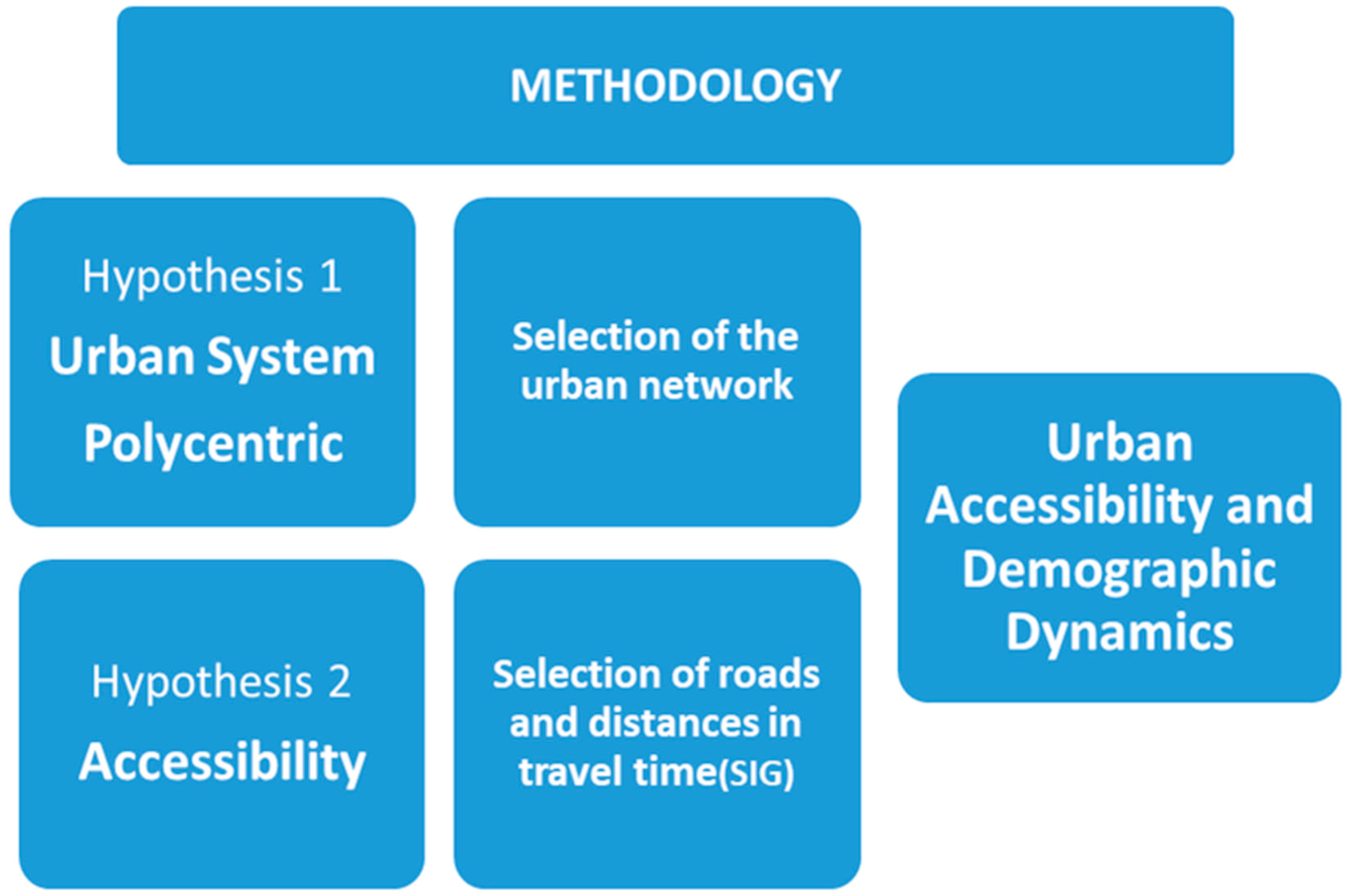
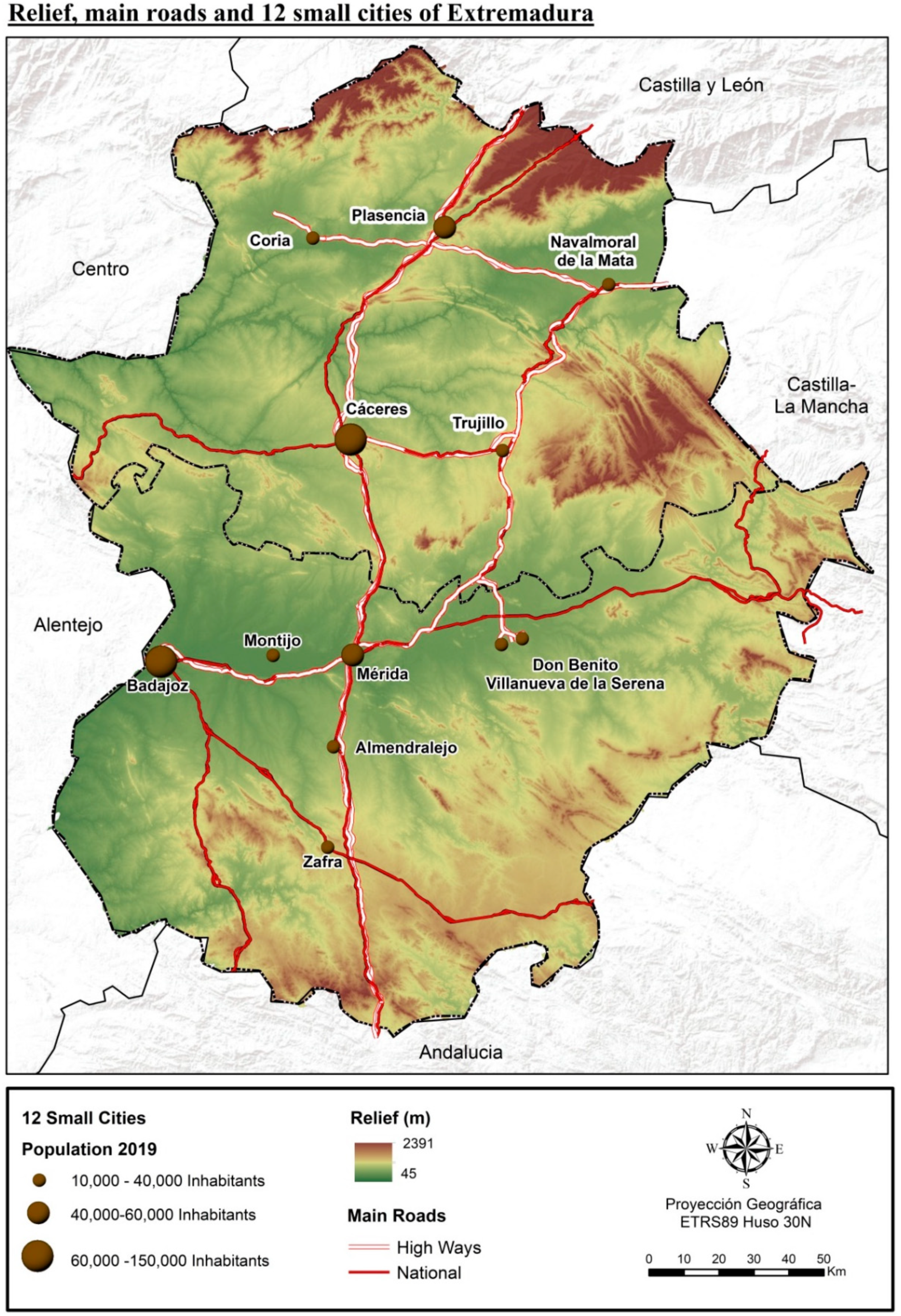
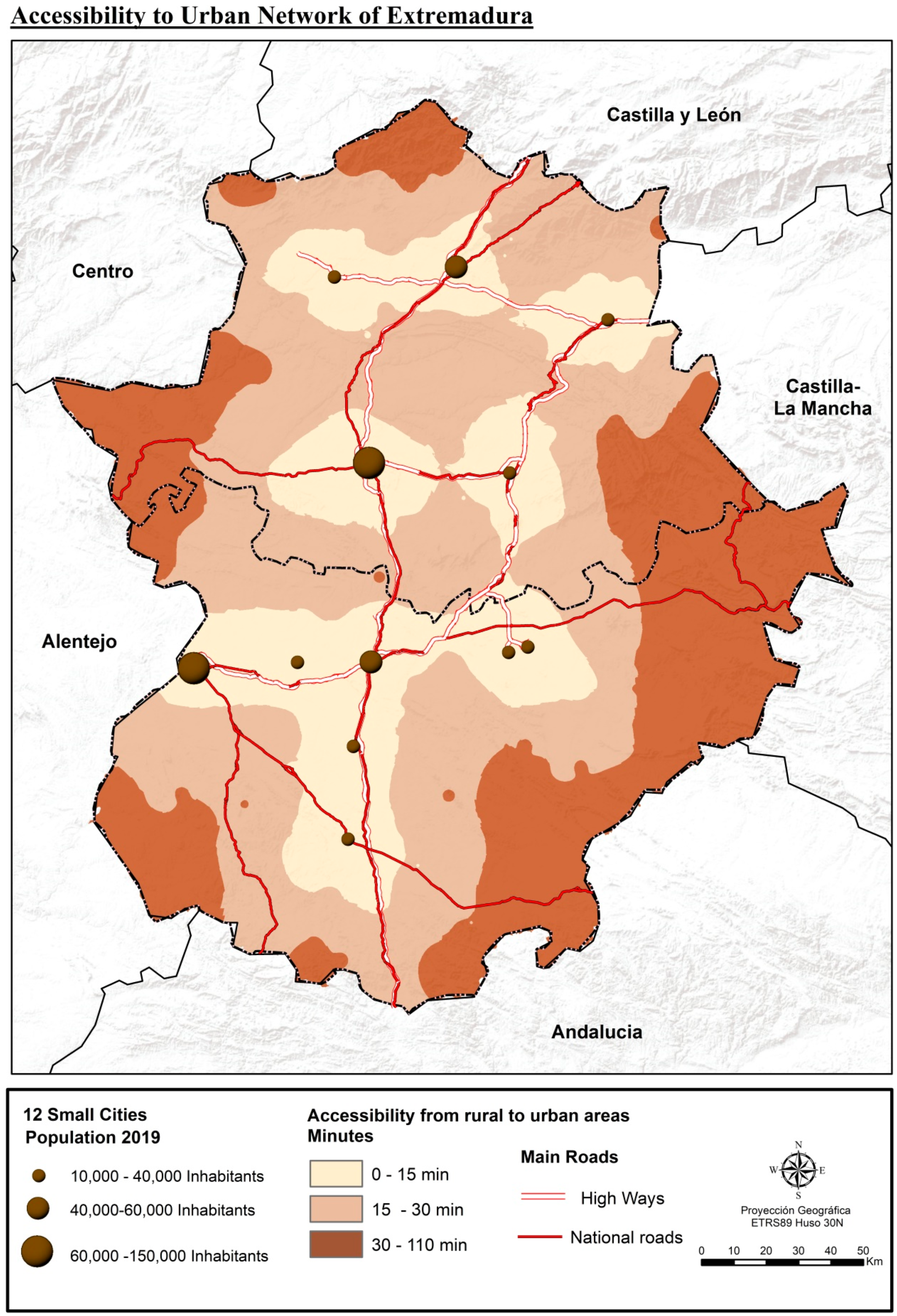
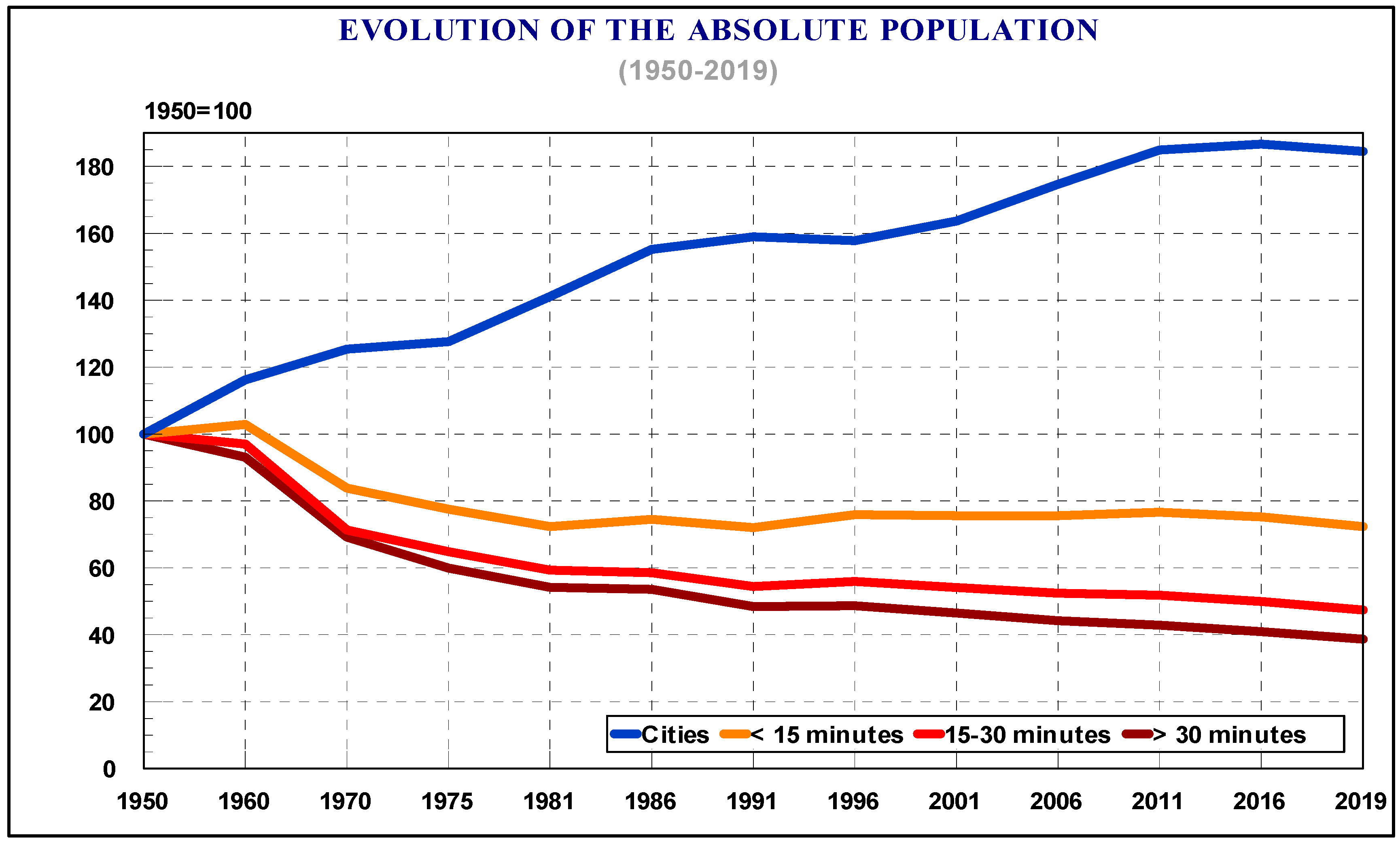

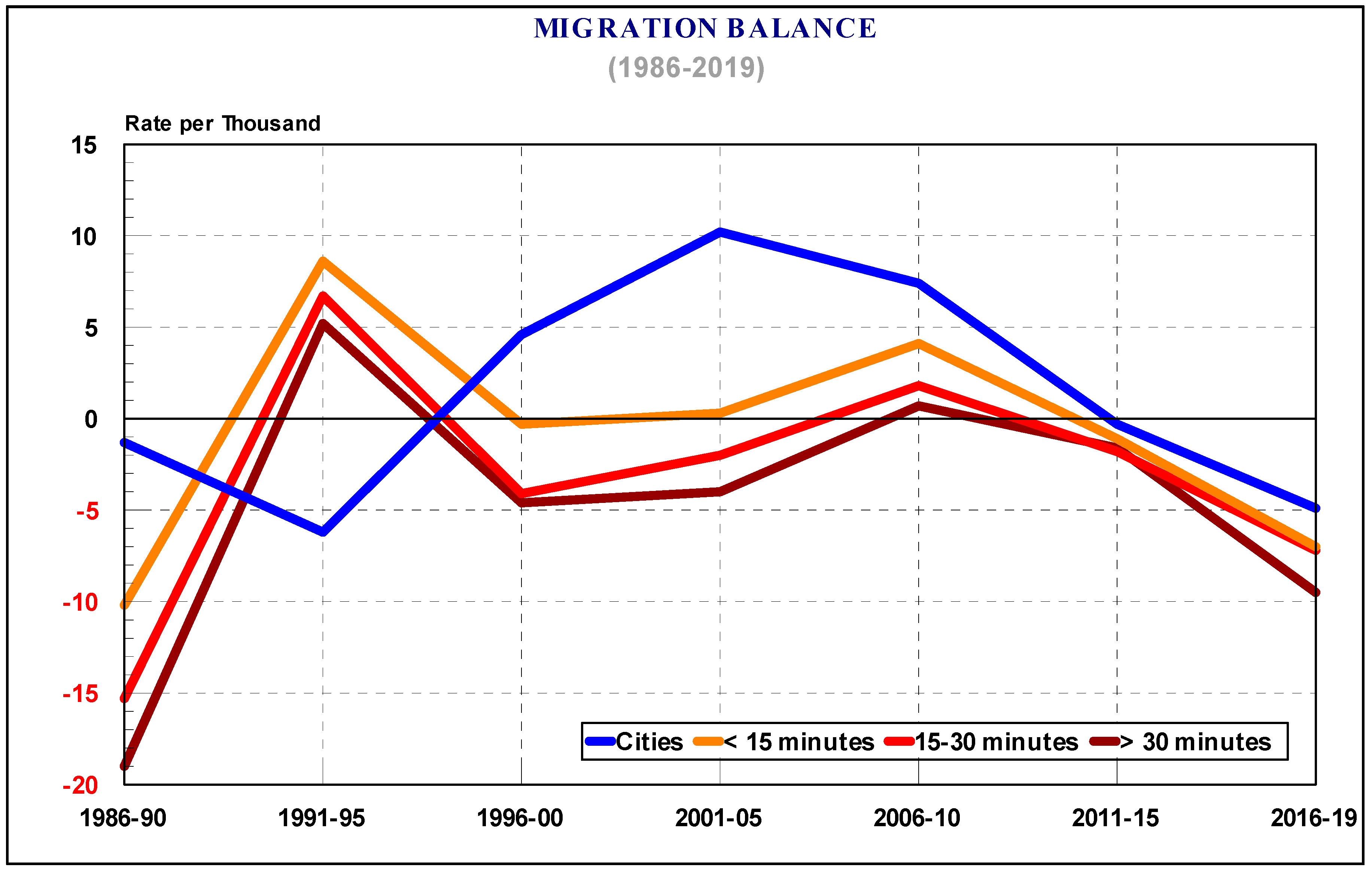
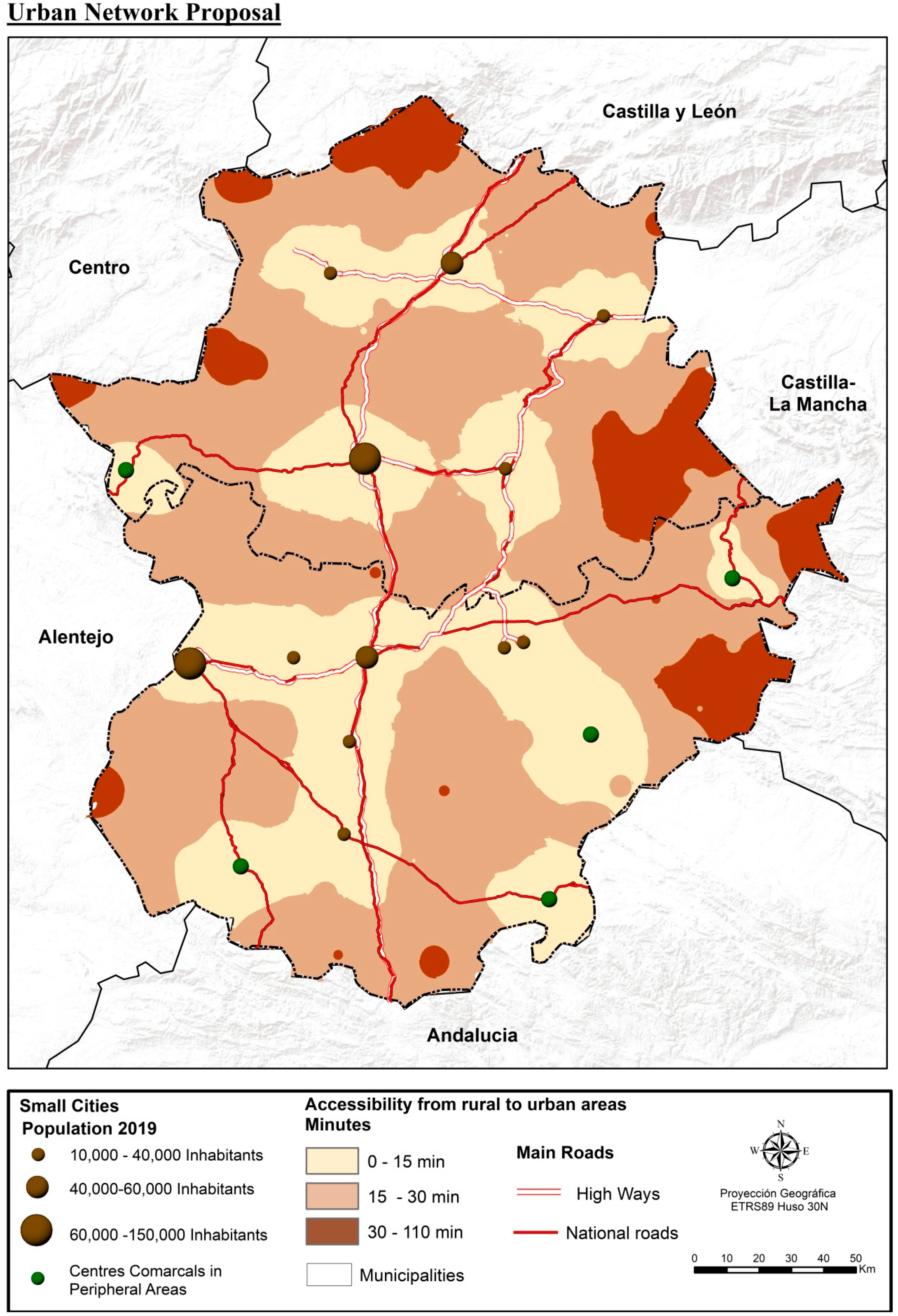
| Small Cities | <15′ | 15–30′ | >30′ | |
|---|---|---|---|---|
| 1950 | 100.0 | 100.0 | 100.0 | 100.0 |
| 1960 | 116.2 | 102.9 | 97.0 | 93.1 |
| 1970 | 125.4 | 83.8 | 71.3 | 69.2 |
| 1975 | 127.6 | 77.5 | 64.8 | 59.9 |
| 1981 | 141.1 | 72.3 | 59.3 | 54.2 |
| 1986 | 155.2 | 74.5 | 58.5 | 53.6 |
| 1991 | 159.0 | 72.0 | 54.4 | 48.4 |
| 1996 | 157.8 | 75.9 | 55.9 | 48.7 |
| 2001 | 163.7 | 75.6 | 54.1 | 46.5 |
| 2006 | 174.7 | 75.6 | 52.4 | 44.2 |
| 2011 | 184.9 | 76.6 | 51.8 | 42.9 |
| 2016 | 186.7 | 75.2 | 49.9 | 40.9 |
| 2019 | 184.5 | 72.3 | 47.4 | 38.7 |
| Small Cities | <15 min | 15–30 min | >30 min | Total Population | |
|---|---|---|---|---|---|
| 1950 | 20.4 | 18.9 | 34.7 | 25.9 | 100 |
| 1960 | 23.5 | 19.3 | 33.3 | 23.9 | 1000 |
| 1970 | 30.5 | 18.8 | 29.4 | 21.3 | 100 |
| 1975 | 33.1 | 18.6 | 28.5 | 19.7 | 100 |
| 1981 | 37.4 | 17.7 | 26.7 | 18.2 | 100 |
| 1986 | 39.6 | 17.6 | 25.4 | 17.4 | 100 |
| 1991 | 41.9 | 17.6 | 24.4 | 16.2 | 100 |
| 1996 | 41.0 | 18.3 | 24.7 | 16.1 | 100 |
| 2001 | 42.6 | 18.2 | 23.9 | 15.3 | 100 |
| 2006 | 44.8 | 18.0 | 22.8 | 14.4 | 100 |
| 2011 | 46.4 | 17.8 | 22.1 | 13.7 | 100 |
| 2016 | 47.5 | 17.7 | 21.6 | 13.2 | 100 |
| 2019 | 48.4 | 17.6 | 21.1 | 12.9 | 100 |
| Gross Birth Rate | Gross Mortality Rate | |||||||
| Small Cities | <15 min | 15–30 min | <30 min | Small Cities | <15 min | 15–30 min | <30 min | |
| 1986–1990 | 13.5 | 13.2 | 12 | 11 | 7.3 | 9.8 | 11.2 | 12.3 |
| 1991–1995 | 12.2 | 11.6 | 10 | 9.1 | 7.5 | 9.7 | 11.3 | 13 |
| 1996–2000 | 10.8 | 9.7 | 8.5 | 7.8 | 8 | 10 | 11.2 | 12.6 |
| 2001–2005 | 10.9 | 8.9 | 7.7 | 6.9 | 8.1 | 10.1 | 11.4 | 13 |
| 2006–2010 | 11.6 | 8.6 | 7.2 | 6.6 | 7.6 | 10.2 | 11.3 | 13.4 |
| 2011–2015 | 10.1 | 7.9 | 6.7 | 6 | 7.8 | 10.5 | 12.2 | 13.9 |
| 2016–2019 | 8.9 | 7.5 | 6.3 | 6 | 7.9 | 11.4 | 13 | 15.1 |
| Vegetative Growth Rate | Migratory Balance Rate | |||||||
| Small Cities | <15 min | 15–30 min | <30 min | Small Cities | <15 min | 15–30 min | <30 min | |
| 1986–1990 | 6.2 | 3.3 | 0.9 | −1.3 | −1.3 | −10.2 | −15.3 | −19 |
| 1991–1995 | 4.7 | 1.8 | −1.3 | −3.9 | −6.2 | 8.6 | 6.7 | 5.2 |
| 1996–2000 | 2.8 | −0.3 | −2.7 | −4.8 | 4.6 | −0.3 | −4.1 | −4.6 |
| 2001–2005 | 2.8 | −1.2 | −3.7 | −6.1 | 10.2 | 0.3 | −2 | −4 |
| 2006–2010 | 4 | −1.6 | −4.1 | −6.8 | 7.4 | 4.1 | 1.8 | 0.7 |
| 2011–2015 | 2.3 | −2.6 | −5.4 | −8 | −0.3 | −1.1 | −1.8 | −1.6 |
| 2016–2019 | 1 | −3.9 | −6.7 | −9.1 | −4.9 | −7 | −7.2 | −9.5 |
| Minutes/Rates | Small Cities | <15′ | 15–30′ | >30′ |
|---|---|---|---|---|
| Total number of municipalities | 12.0 | 93.0 | 176.0 | 101.0 |
| Population 2019 (%) | 48.8 | 17.6 | 21.1 | 12.9 |
| Average age | 41.1 | 46.3 | 49.1 | 50.2 |
| Active population (%) | 67.8 | 63.7 | 61.0 | 60.3 |
| Young population (%) | 15.5 | 11.1 | 9.6 | 9.5 |
| Senile population (%) | 16.7 | 25.2 | 29.5 | 31.1 |
| Dependency Index (%) | 49.8 | 60.5 | 67.7 | 71.1 |
© 2020 by the authors. Licensee MDPI, Basel, Switzerland. This article is an open access article distributed under the terms and conditions of the Creative Commons Attribution (CC BY) license (http://creativecommons.org/licenses/by/4.0/).
Share and Cite
Gurría Gascón, J.L.; Nieto Masot, A. Rururban Partnerships: Urban Accessibility and Its Influence on the Stabilization of the Population in Rural Territories (Extremadura, Spain). Land 2020, 9, 254. https://doi.org/10.3390/land9080254
Gurría Gascón JL, Nieto Masot A. Rururban Partnerships: Urban Accessibility and Its Influence on the Stabilization of the Population in Rural Territories (Extremadura, Spain). Land. 2020; 9(8):254. https://doi.org/10.3390/land9080254
Chicago/Turabian StyleGurría Gascón, José Luis, and Ana Nieto Masot. 2020. "Rururban Partnerships: Urban Accessibility and Its Influence on the Stabilization of the Population in Rural Territories (Extremadura, Spain)" Land 9, no. 8: 254. https://doi.org/10.3390/land9080254
APA StyleGurría Gascón, J. L., & Nieto Masot, A. (2020). Rururban Partnerships: Urban Accessibility and Its Influence on the Stabilization of the Population in Rural Territories (Extremadura, Spain). Land, 9(8), 254. https://doi.org/10.3390/land9080254






